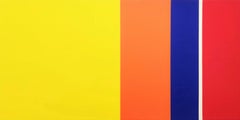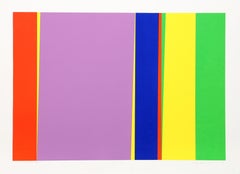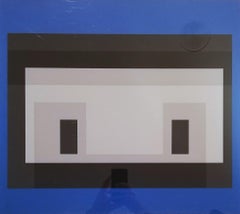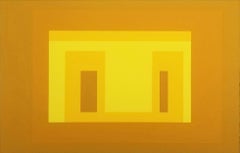Jay Rosenblum Abstract Prints
American, 1933-1989
Jay Rosenblum experimented with different versions of the "Visual Stripe motif" for more than thirty years. In the 1960's he developed a "hard-edge" style with "flat curtain forms" which had a clearly defined vertical emphasis. These colors as in our example move up and down the picture plane. Space is defined by shifts in color passages. As the artist explained in his own words:
"The vertical forms in my work serve as the vehicle for color and also become a dramatic means of achieving movement and deep space. This becomes possible through a great variation in the stripe thickness and the sudden emergence or disappearance of a particular band of color when it overlaps another."
Rosenblum was an ardent violinist who played for the Seventh Army Symphony in West Germany and who was also an art teacher at the School of Visual Arts. In his art Rosenblum sought to associate his great love for chamber music sonatas with his freely evolving vertical stripes of color. Rosenblum once stated:
"When these elements engage themselves in the painting, there is a great visual excitement for me. A kinship with music, in a polyphonic sense, is very strong in that simultaneously one hears lines of "overlapping" music. In some mysterious way the composer can achieve this and it is equally mysterious and effective in painting when it happens."
In much the same way that singular notes strung together create music, individual stripes of color together can be transformed into a complete art form. He thus viewed these blocks of color almost as separate notes in a piece of music that that when brought together would be transformed into a cohesive unit, resonating with a playfulness that added interest and energy to the picture. With colors Rosenblum attempted to select ones that when juxtaposed against or near one another would become "an exciting visual discovery". He would refer to such works as "free association color development". Rosenblum executed a number of these "hard-edge" paintings which included groupings of color clusters in both vertical and diagonal motifs.
Jay Rosenblum was born in New York City in 1933. He attended the Pratt Institute in Brooklyn from 1951-53, Harvard University in the summer of 1953 and Bard College in Annandale-on-Hudson, NY 1953-1955. He received a M.F.A. from Cranbrook Academy of Art in Bloomfield Hills, MI. His paintings have appeared in numerous selected solo and group exhibitions in the USA and Italy. Rosenblum was awarded the Carlos Lopez Memorial Prize in painting from the Detroit Institute of Art in Detroit, Michigan in 1955 and the Painter of the Year Award from Larry Aldrich, Ridgefield, CT in 1970. He lived and worked in Manhattan for most of his life and sadly died in a tragic bicycle accident in 1989.to
1
2
2
1
Overall Width
to
Overall Height
to
4
15
637
205
165
164
5
5
4
1
4
1
5
Artist: Jay Rosenblum
Cycle 3, Minimalist Geometric Screenprint by Jay Rosenblum
By Jay Rosenblum
Located in Long Island City, NY
Artist: Jay Rosenblum, American (1933-1989
Title: Cycle 3
Year: 1979
Medium: Screenprint, signed and numbered in pencil
Edition size: 250
Size: 25 in. x 29.5 in. (63.5 cm x 74.93 cm)
Category
1970s Abstract Geometric Jay Rosenblum Abstract Prints
Materials
Screen
$595 Sale Price
40% Off
Grove #1 /// Abstract Geometric Colorful Jay Rosenbulm New York Screenprint Art
By Jay Rosenblum
Located in Saint Augustine, FL
Artist: Jay Rosenblum (Americam, 1933-1989)
Title: "Grove #1"
*Signed by Rosenblum in pencil lower right
Year: 1979
Medium: Original Screenprint on white Stonehenge paper
Limited edi...
Category
1970s Abstract Geometric Jay Rosenblum Abstract Prints
Materials
Screen
Cycle 2, Colorful Abstract Screenprint by Jay Rosenblum
By Jay Rosenblum
Located in Long Island City, NY
Artist: Jay Rosenblum, American (1933-1989
Title: Cycle 2
Year: 1979
Medium: Screenprint, signed and numbered in pencil
Edition size: 250
Size: 25 in. x 34.5 in. (63.5 cm x 87.63 cm)
Category
1970s Color-Field Jay Rosenblum Abstract Prints
Materials
Screen
Striped Abstract in Pastel Colors, Lithograph by Jay Rosenblum
By Jay Rosenblum
Located in Long Island City, NY
This lithograph was created by New York-born artist Jay Rosenblum. In his art, he seeks to correlate his great love for chamber music sonatas with freely evolving blocks of color whi...
Category
1970s Abstract Jay Rosenblum Abstract Prints
Materials
Lithograph
Cycle 1, Colorfield Abstract Screenprint by Jay Rosenblum
By Jay Rosenblum
Located in Long Island City, NY
Artist: Jay Rosenblum, American (1933-1989
Title: Cycle 3
Year: 1979
Medium: Serigraph, signed and numbered in pencil
Edition size: 250
Size: 25 in. x 25 in. (63.5 cm x 63.5 cm)
Category
1970s Abstract Geometric Jay Rosenblum Abstract Prints
Materials
Screen
Related Items
MMA-3 Variant /// Josef Albers Abstract Geometric Screenprint Color Field Theory
By Josef Albers
Located in Saint Augustine, FL
Artist: Josef Albers (German-American, 1888-1976)
Title: "MMA-3 Variant"
Series: MMA (Metropolitan Museum of Art)
*Unsigned edition
Year...
Category
1970s Abstract Geometric Jay Rosenblum Abstract Prints
Materials
Screen
$3,000
H 26.44 in W 28.57 in
Variant I /// Josef Albers Abstract Geometric Screenprint Minimalism Bauhaus Art
By Josef Albers
Located in Saint Augustine, FL
Artist: Josef Albers (German-American, 1888-1976)
Title: "Variant I"
Portfolio: Ten Variants
*Unsigned edition
Year: 1967
Medium: Original Screenprint on Rives BFK paper
Limited edit...
Category
1960s Abstract Geometric Jay Rosenblum Abstract Prints
Materials
Screen
Prizma IV (Geometric Abstraction)
By Marko Spalatin
Located in Kansas City, MO
Prizma IV
Color silkscreen
Signed and titled by hand
Size: 20.3 × 20.3 on 28.9 × 25.0 inches
COA provided
Marko Spalatin was born in Zagreb, Croatia. He immigrated to the US in his ...
Category
2010s Abstract Geometric Jay Rosenblum Abstract Prints
Materials
Screen
Arrived /// Bauhaus Abstract Geometric Josef Albers Screenprint Yellow Minimal
By Josef Albers
Located in Saint Augustine, FL
Artist: Josef Albers (German-American, 1888-1976)
Title: "Arrived"
Portfolio: Soft Edge - Hard Edge
*Signed and dated by Albers in pencil lower right
...
Category
1960s Abstract Geometric Jay Rosenblum Abstract Prints
Materials
Screen
JHM - II /// Bauhaus Abstract Geometric Josef Albers Screenprint Minimalism
By Josef Albers
Located in Saint Augustine, FL
Artist: Josef Albers (German-American, 1888-1976)
Title: "JHM - II"
Portfolio: Josef Albers Honors the Hirshhorn Museum and Sculpture Garden
*Monogram signed and dated by Albers in p...
Category
1970s Abstract Geometric Jay Rosenblum Abstract Prints
Materials
Screen
$15,000
H 26.5 in W 36.63 in
Composition 1996
By Jesús Rafael Soto
Located in Miami, FL
Composition 1996
Silkscreen in colors on Arches paper
21.7 x 29.5 in (55 x 75 cm)
Editioned upper left and signed upper right
Edition of 99
Jesús Rafael Soto was born on June 5, 19...
Category
1960s Abstract Geometric Jay Rosenblum Abstract Prints
Materials
Lithograph
“Three Movements" Limited Edition Hand-Signed Serigraph by Yaacov Agam, Framed
By Yaacov Agam
Located in Encino, CA
"Three Movements," an original silkscreen by Yaacov Agam, is a piece for the true collector. Agam is considered the father of Kinetic art. His iconic style is recognizable across the...
Category
1970s Kinetic Jay Rosenblum Abstract Prints
Materials
Screen
$5,000
H 30.125 in W 41.875 in D 1.25 in
African Suite Monaco 1980 Limited Edition Silkscreen
Located in Rochester Hills, MI
Pierre Clerk
African Suite #7 Monaco - 1980
Print - Silkscreen, on Arches archival paper 30.5'' x 19.5''
Edition: Signed in pencil, dated and marked 173/200
unframed
The images of ...
Category
1980s Abstract Geometric Jay Rosenblum Abstract Prints
Materials
Screen
Variant II /// Josef Albers Abstract Geometric Screenprint Minimalism Bauhaus
By Josef Albers
Located in Saint Augustine, FL
Artist: Josef Albers (German-American, 1888-1976)
Title: "Variant II"
Portfolio: Ten Variants
*Unsigned edition
Year: 1967
Medium: Original Screenprint on Rives BFK paper
Limited edi...
Category
1960s Abstract Geometric Jay Rosenblum Abstract Prints
Materials
Screen
Frank Stella Attica Defense Fund historic LtEd offset lithograph abstract print
By Frank Stella
Located in New York, NY
Another example of this iconic Frank Stella print can be found at the Poster House Museum in Manhattan. For inspiration only are photographs from their display.
"The concentric squ...
Category
1970s Abstract Geometric Jay Rosenblum Abstract Prints
Materials
Lithograph, Offset
$8,000
H 29.5 in W 29.5 in
Untitled (Geometric Abstraction Minimalism, ~60% OFF LIST PRICE)
By Max Bill
Located in Kansas City, MO
Max Bill
Composition with white center
Color silkscreen
Year: 1972
Edition: Edition for "Look at"
Size: 23.3 × 23.3 inches
Unsigned, unknown edition size (pres. ~2,000) - sometimes a...
Category
1970s Abstract Geometric Jay Rosenblum Abstract Prints
Materials
Screen
$188 Sale Price
65% Off
H 23.3 in W 23.3 in
Magic Rainbow II, Limited Edition Signed Print
By Yaacov Agam
Located in San Rafael, CA
Yaacov Agam (b. 1928)
Magic Rainbow II, late 20th century
Screenprint in colors on wove paper
LXIII/XC (edition 63/90)
Signed and numbered in pencil along lower edge
13 x 15...
Category
Late 20th Century Abstract Geometric Jay Rosenblum Abstract Prints
Materials
Screen
Previously Available Items
Cycle 2
By Jay Rosenblum
Located in Long Island City, NY
Artist: Jay Rosenblum, American (1933 - 1989)
Title: Cycle 2
Year: 1979
Medium: Serigraph, signed, dated and numbered in pencil
Edition: 250, 50
Size: 25 in. x 34.5 in. (63.5 cm x 87...
Category
1970s Abstract Jay Rosenblum Abstract Prints
Materials
Screen
Groove
By Jay Rosenblum
Located in Long Island City, NY
Artist: Jay Rosenblum, American (1933 - 1989)
Title: Groove
Year: 1981
Medium: Serigraph, signed and numbered in pencil
Edition: 300
Size: 24.5 x 42.5 in. (62.23 x 107.95 cm)
Category
1980s Minimalist Jay Rosenblum Abstract Prints
Materials
Screen
Groove
By Jay Rosenblum
Located in Long Island City, NY
Artist: Jay Rosenblum, American (1933-1989
Title: Groove
Year: 1981
Medium: Serigraph, signed and numbered in pencil
Edition size: 300
Size: 24.5 x 42.5 in. (62.23 x 107.95 cm)
Category
1980s Abstract Jay Rosenblum Abstract Prints
Materials
Screen
Bridge, Geometric Stripe Silkscreen by Jay Rosenblum
By Jay Rosenblum
Located in Long Island City, NY
Artist: Jay Rosenblum, American (1933 - 1989)
Title: Bridge
Year: 1982
Medium: Serigraph, signed and numbered in pencil
Edition: 250
Image Size: 15 x 35 inches
Size: 20.5 x 40 ...
Category
1980s Abstract Geometric Jay Rosenblum Abstract Prints
Materials
Screen
Arcadia 5
By Jay Rosenblum
Located in Long Island City, NY
Artist: Jay Rosenblum, American (1933 - 1989)
Title: Arcadia 5
Year: 1979
Medium: Serigraph, signed and numbered in pencil
Edition: AP 18/32
Image Size: 18 x 36 inches
Size: 23...
Category
1970s Abstract Geometric Jay Rosenblum Abstract Prints
Materials
Screen
Jay Rosenblum abstract prints for sale on 1stDibs.
Find a wide variety of authentic Jay Rosenblum abstract prints available for sale on 1stDibs. If you’re browsing the collection of abstract prints to introduce a pop of color in a neutral corner of your living room or bedroom, you can find work that includes elements of blue, orange, yellow and other colors. You can also browse by medium to find art by Jay Rosenblum in screen print, lithograph and more. Much of the original work by this artist or collective was created during the 1970s and is mostly associated with the abstract style. Not every interior allows for large Jay Rosenblum abstract prints, so small editions measuring 25 inches across are available. Customers who are interested in this artist might also find the work of Robert Squeri, Arnold Hoffmann, and Ray Elman. Jay Rosenblum abstract prints prices can differ depending upon medium, time period and other attributes. On 1stDibs, the price for these items starts at $800 and tops out at $1,000, while the average work can sell for $900.



